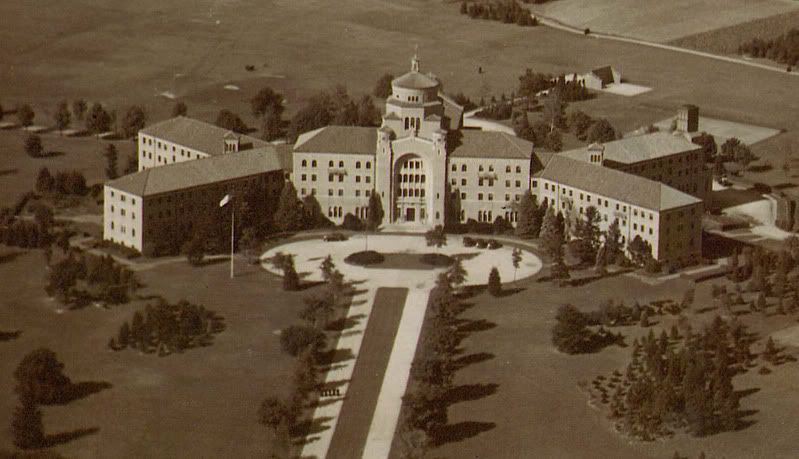Back in 1985, an approving New York Times article described the newly adapted mission of the Immaculate Conception Seminary in Huntington. Openly predicting that the Church would have more lay ministers than priests by the year 2000, the administration was actively expanding its role in educating lay people and women religious. As the article explained, the seminary was now perfectly content to see ‘itself more as an educational resource than as the monastic theological academy it once was.’

Immaculate Conception Seminary, circa 1930
This change in mission would have been surprising news to Immaculate Conception’s founder, Archbishop Thomas Molloy. I recently came across his 1930 speech at the Seminary’s dedication. In it, he outlined the new Seminary's purpose and usefulness in an extraordinary speech. Bishop Molloy was a noted orator, and this speech is no exception.
I was instantly struck by the energy and vitality of the lines. It is obvious that the bishop was no shrinking violet. Though brief, the speech is elegant but forceful, liberally sprinkled with powerful phrases and rich theological language. The man clearly knew how to pack his punches!
Some excerpts from his extraordinary speech: ( I couldn’t resist highlighting the best parts.)
On the mission of the new Seminary:
"Within the walls of this institution by means of devout prayer, worthy reception of the Sacraments, faithful practice of piety and diligent study (the Catholic students) will earnestly seek to acquire supernatural grace, spiritual enlightenment, intellectual culture, moral discipline and a Christlike love for their fellow human beings so that they may later realize their vocation and fulfill their mission as spiritual leaders, religious teachers, ambassadors of Christ and zealous priests of God."
How’s that for starters? As if that weren’t clear enough, he adds this little gem:
"In this school of Christian piety and learning, moreover, our young candidates for the sacerdotal state and office will strive to learn clearly and accurately the mind, will and plan of God regarding the sanctification of human souls."
"Salus animarum Suprema lex" (The salvation of souls is the supreme law), by the way, was the motto on the Bishop’s coat-of-arms and is inscribed on his imposing episcopal throne which is still preserved and on display at the Seminary.
On the spiritual mission of the new priest:
"After six years of careful, thorough study, discipline and training and, found to be duly qualified and worthy, they will be sacramentally endowed with priestly character and formally delegated by ecclesiastical authority to preach the saving gospel of Jesus Christ and to regenerate, revivify, purify and sanctify countless souls of saints and sinners by public prayer, by celebration of the Eucharistic Sacrifice, and by the administration of the Sacraments of the living and the dead."
Notice, if you will, the Bishop’s very Roman practice of using verbs, adjectives and phrases in clusters of three and four. This is found in the Roman Canon, e.g., ‘hostiam puram, hostiam sanctam, hostiam immaculatam.’ Some may find this stiff and legalistic, but it is an economical way both to clarify and, at the same time, amplify the concepts being discussed.
On the public mission of the new priest:
". . . the intellectually trained, morally sound, spiritually motivated young men will . . . preach and teach in season and out of season obedience to law, respect for authority, regard for the rights of others, and love for one’s fellow man."
Priests as public advocates and guardians:
"They will also prove to be, moreover, staunch defenders of the weak, of the unfortunate, of the under-privileged, and even the unborn. They will serve as fearless advocates of liberty under law, of the sacredness of property right, of the sanctity of marriage, of integrity of character in public office and of faithful fulfillment of the duties of honorable, useful private citizenship."
What a compelling vision of the priesthood! He expected his priests to take an active, vocal part in the community and be watchdogs of sorts for the weak and defenseless, while maintaining a vigilant watch on the laws and the lawmakers.
With such a bold leader and clearly defined purpose, it is no wonder the Seminary thrived under Bishop Molloy’s direction. Well over 500 priests were ordained from its founding to the time of his death in 1956 (an average of 35 priests a year!). There was certainly no confusion and disorder in his ranks—as anyone might guess from reading his speeches! But, despite his dignified and imposing presence, he was well-loved and esteemed by his students and by many who knew him, and that makes his amazing legacy even brighter still.

2 comments:
Great piece! Oh if we could have such numbers of orthodox priests in the seminary again. What a powerhouse it would be. We need priests with backbone! But as Bishop Sheen used to say, "You get the priests you pray for."
Thanks, Veritas. Nice name, by the way. Great bishops attract good vocations---and lots of them. Just look at Bp. Bruskewitz in Nebraska!
There's no vocation shortage there. The number of vocations seems to be an indicator of the spiritual health of a diocese.
---Mater Catolica
Post a Comment